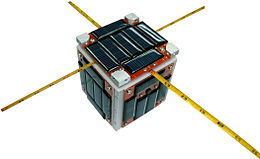F-1 is a 1U CubeSat built by FSpace laboratory at FPT University in Vietnam, in partnership with Angstrom Space Technology Center (ASTC), Uppsala University and NanoRacks LLC. Its mission is to train young engineers and students about aerospace engineering and evaluate an advanced 3-axis magnetometer (SDTM) designed in Sweden by ASTC.
F-1 was launched on 21 July 2012 and delivered to International Space Station (ISS) aboard Kounotori 3 along with the Raiko, We Wish, Niwaka and TechEdSat cubesats. Then, on October 4, 2012, it was deployed into orbit from ISS using JEM Small Satellite Orbital Deployer (J-SSOD) which was attached to the Kibo module's robotic arm. As of November 2, 2012, F-1 failed to confirm communication after the orbital deployment.
Structure: aluminium alloy T-6061Power supply: body-mounted solar cells, rechargeable Li-Polymer batteryPIC16 and PIC18 micro-controllersYaesu VX-3R handheld transceiversC328 low-resolution cameraTemperature sensors3-axis magnetometer (ASTC)2 meter band Dipole Antenna70cm band Dipole AntennaSize: 10x10x10cm (1U cubesat)Mass: 1 kgCommunication: 02 independent radios using amateur radio VHF & UHF bands, transmission speed 1200bit/s; AFSK & PWM Morse code modulation, KISS protocolPayload: low resolution C328 camera (640×480 maximum resolution, 8 bit color)Sensors: temperature sensors and 3-axis magnetometerTargeted orbit lifetime: at least 3 months on orbit (depend on release altitude from the ISS)1. Backup UHF channel (only operational in daylight):
Frequency: 437.485 MHzModulation: Narrow FMPower: about 0.2W RF outputAntenna: half-wave dipoleBeacon interval: 20 seconds duration, repeated every 90 secondsPulse-Width-Modulation Morse code telemetry beacon
2. Main VHF channel (operational during night time but may be turned on in daylight later)
Frequency: 145.980 MHzModulation scheme: AFSK/FMPower: 1.0W RF outputAntenna: half-wave dipoleBaud rate: 1200bit/sTelemetry and interval: one burst of 3 telemetry packets in KISS format every 30 seconds (interval configurable)F-1’s KISS packet format
Note:
F-1 periodically sends a burst of 3 telemetry packets with the same content, to avoid loss of packetTime in UTC, 24 hours formatYear count starting from 2012 (2012 equals 0, 2013 equals 1 and so on…)Battery voltage reading is accurate to 0.01V, values are multiplied by 100. Divide by 100 to get actual value.Solar cells voltage reading is accurate to 0.1V, values are multiplied by 10. Divide by 10 to get actual value.Temperature readings from sensors, will be added with 100 before transmission to ensure a positive number so please subtract 100 to get actual value112 bits, divide to 14 chunks of 8 bits, each chunk becomes one byte 
